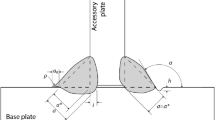Abstract
Internal weld imperfections and defects affect the fatigue behavior of the welded joints significantly. Their effects become more important when the weld seam does not have a sharp weld toe transition. These imperfections and defects in the welded area are classified by different instructions such as the DVS-guideline or the IIW recommendation. These instructions and guidelines introduce different FAT classes for the same weld imperfection type. FAT is the magnitude of the stress to failure in two million cycles. Furthermore, they do not take into account the importance of the position and the size of weld imperfections. This introduces uncertainty for the user due to differences between guidelines and the lack of information. As a result, in order to eliminate the inconsistency in the available weld recommendations and guidelines, it is necessary to perform a new investigation on different weld imperfections. This study considers the effects of imperfections on the weld quality both experimentally and numerically. The experimental study considered the effect of weld imperfections on weld quality with respect to the post weld treatment procedure on the weld seam. Then, a numerical method was introduced and validated by experimental results to predict the fatigue life in crack initiation and propagation steps. Fatemi-Socie approach as a fatigue damage model and fracture mechanics estimated the fatigue life in the crack initiation and propagation steps, respectively. The experimental and numerical results were plotted in S-N diagrams, and based on this work, new FAT classes were recommended. It was seen that if the type of weld defect is a single pore, the suggested value by IIW recommendation is more realistic than the other guidelines.



















Similar content being viewed by others
Change history
05 August 2019
In the original version of this article the author Ren�� Fenzl is missing due to an oversight.
References
Harrison, J. D., and J. Doherty., (1977), A reanalysis of fatigue data for butt welded specimens containing slag inclusions, The welding institute.
Hobbacher A, Kassner M, Welding in the World (2012) On relation between fatigue properties of welded joints, quality criteria and groups in Iso. 5817(56):153–169. https://doi.org/10.1007/BF03321405
Standard Volvo Group, (2008), Weld classes and requirements life-optimized welded structures steel, Tech no STD 181-0004
Miki Ch., Nishikawa K., Takahashi M. and Konishi T., (2002), Effects of embedded defects on fatigue performance of horizontal transverse butt welded joint settings of requested acceptable quality levels, International Institute of Welding, Paris, IIW Doc. XIII-1954-02
Hobbacher AF (2016) Recommendations for fatigue design of welded joints and components. Springer International Publishing
German Welding Society, (2011), DVS 0705: Empfehlungen zur Auswahl der Bewertungs gruppen nach ISO 5817 (recommendations for selection of quality level according to ISO 5817 Düsseldorf, Germany
Fatemi A, Socie DF (1988) A critical plane approach to multiaxial fatigue damage including out-of-phase loading. Fatigue Fract Eng Mater Struct 11(3):149–165. https://doi.org/10.1111/j.1460-2695.1988.tb01169.x
VERB-Manual, (2016), User Guide für das Programm VERB, Fraunhofer IWM
BS EN 10113-2:1993, (Withdrawn 2004), Hot-rolled products in weldable fine grain structural steels. Delivery conditions for normalized/normalized rolled steels, ISBN: 0 580 21354 4
M. Farajian et al., (2015), Quantifizierung des Einflusses der Nahtqualität auf die Ermüdungsfestigkeit von Schweißverbindungen, IGF-17.559B/DVS-Nr. 09.055, IWM-Abschlussbericht: 183/2016
ISO 5817:2014, (2014), Welding-fusion-welded joints in steel, nickel, titanium and their alloys (beam welding excluded) - quality levels for imperfections
Metallic materials - tensile testing, (2001), Part 1: method of testing at ambient temperature; German version EN 10002–1
Lemaitre J, Chaboche J-L (1990) Mechanics of solid materials. Press, Cambridge University
DIN EN ISO 6507-4:2006–03, (2006), Metallische Werkstoffe-Härteprüfung nach Vickers-Teil 4: Tabellen zur Bestimmung der Härtewerte (ISO 6507-4:2005); Deutsche Fassung EN ISO 6507–4:2005
Liu Y, Mahadevan S (2005) Multiaxial high-cycle fatigue criterion and life prediction for metals. Int J Fatigue 27:790–800
Brown M, Miller KJ (1973) A theory for fatigue under multiaxial stress-strain conditions. Institute 439 of Mech Engineers 187:745–756
Smith RN, Watson P, Topper TH (1970) A stress-strain parameter for the fatigue of metals. J 443 of Materials 5(4):767–778
Roessle M, Fatemi A (2000) Strain-controlled fatigue properties of steels and some simple approximations. Int J Fatigue 22(6):495–511. https://doi.org/10.1016/s0142-1123(00)00026-8
Author information
Authors and Affiliations
Corresponding author
Additional information
Recommended for publication by Commission XIII - Fatigue of Welded Components and Structures
Rights and permissions
About this article
Cite this article
Javaheri, E., Hemmesi, K., Tempel, P. et al. Fatigue assessment of the welded joints containing process relevant imperfections. Weld World 63, 249–261 (2019). https://doi.org/10.1007/s40194-018-00676-y
Received:
Accepted:
Published:
Issue Date:
DOI: https://doi.org/10.1007/s40194-018-00676-y




